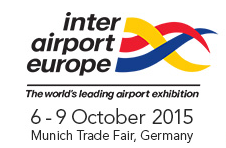A few weeks ago, we got a press release from Data Modul which told us that it would be exhibiting its Conrac flight information displays at the Inter Airport Europe show in Munich this week. As we had to be in the city anyway, we decided to go along. However, it turned out that Conrac was the only interesting brand there from a displays point of view (although there was lots of interest to travellers that spend their lives in airports – a great chance to see “behind the scenes”).
Although a number of other companies at the show were identified on the showguide as being involved with FIDs, they were just involved with data processing or software and were not showing displays.
Data Modul is the owner of the Conrac brand (we hadn’t realised that it is 17 years since the acquisition of Conrac by Data Modul). We have reported elsewhere on the attempt by Arrow Electronics to acquire Data Modul and we heard at the show that there has been no change in the status since our last report. Arrow, which owns the majority of Data Modul now, would like to take over the company completely, but shareholders are reluctant to sell and are blocking a complete takeover.
At the show, there were two new products. The first is a 70″ FullHD display that is designed for indoor use, but where the environment is challenging. The unit is warranted for 24/7 use and is IP54 certified for use in damp or dusty environments. For example, baggage handling areas can be very dirty and dusty, but the firm also expects to see applications in industrial environements such as factories. It has a bonded glass front panel that makes the panel very robust and also means that anti-glare and anti-scratch coatings can be applied.
Conrac’s high brightness monitor will arrive in production in mid-2016The second product that we looked at was the first very high brightness 55″ display from the firm that is designed for outdoor applications. The prototype uses the Samsung 2,500 cd/m² FullHD panel that Samsung has been promoting for some time. The monitor is sealed to IP65 for waterproofing and can be mounted in any orientation. It uses active cooling and heating to ensure correct operation even in the rated operating conditions of -30 deg C to +50 deg C. The firm told us that when it first tested the unit, before some modifications, even when the unit was in a skiing area (typically -20 deg C), it developed black spots from the problems of heat from the sun.
The monitor has an optically bonded front panel with anti-reflective coatings and UV and infrared filters. Mass production will start in the middle of 2016 and the firm expects demand from railways and other outdoor applications as well as airports, where is likely to be used not only in areas such as parking garages, but also in aircraft guidance applications.
The luxury of not having a lot of exhibitors to rush around meant a little more time to chat. Conrac has a long history of success in airports in Germany, with big deals in Frankfurt, Munich, Dusseldorf and Berlin. We reported on the latest Munich deal recently (Conrac Wins Munich T1 Renewal). We discussed the long delayed “new Berlin airport”. This disastrous project is so far behind schedule that the warranty on the FIDs that Conrac delivered has now expired!
The company has also had success around the world, with the Changi airport in Singapore a particular success as the installation uses Conrac’s software as well as displays. In that case, there were enough displays in the project and sufficient knowledge at the airport for great care to be taken in panel choice. While some applications used VA panels because of the better on-axis contrast, the check in desks were often approached from the side, where IPS was specified.
Data Modul is a substantial distributor of LCDs in Europe and as a result has access to a wide range of panels and on the booth there were products based on Samsung, Sharp and LG LCDs. Data Modul is also the biggest distributor for AUO in Europe, so can also access that company’s panels efficiently.
We asked whether there was a feeling of threat from small pitch LED, but at the moment, the belief is that LED products are still too complex to drive and too expensive for airports. It was ironic that when we made it back to the press office, the first email that came through was a press release from Absen about wins in Norway for LEDs in airports! (Absen Flying High with Norwegian Digital Signage Airport Solutions)
The company also plans to stay with FullHD until it is forced to shift away to UltraHD. In FIDs, there is little or no advantage to the higher resolution and a number of disadvantages. However, the compay does expect that there is an inevitability to the arrival of UltraHD panels as standard, eventually.

